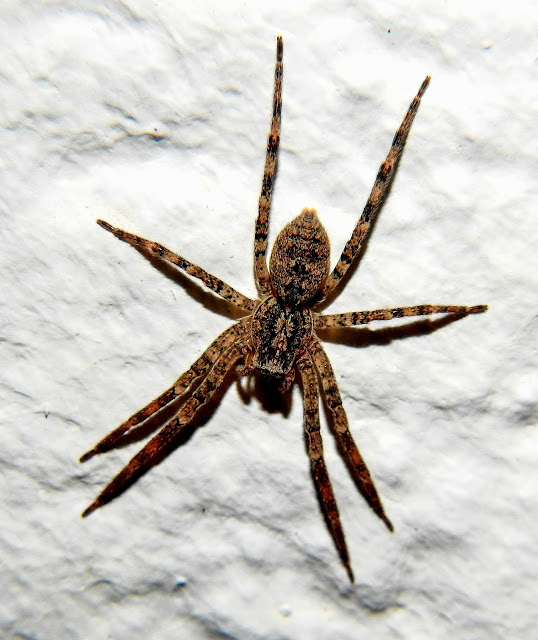This Blog contains Wildlife and Bird Photos from Walks, Safaris, Birding Trips and Vacations. Most of the pictures have been taken with my Nikon P900 and P950X cameras. On the right of the page are labels for each species of Bird/Animal etc. Click on a label and it will show all of the photos taken for that species. I am adding as much information for each species as I can from sources Wikipedia. To see any pictures at full size just click on the picture.
TOTAL PAGEVIEWS
TRANSLATE
Monday 10 December 2018
Sunday 9 December 2018
Saturday 8 December 2018
Friday 7 December 2018
Thursday 6 December 2018
6-12-2018 MONTE CORONA, VALENCIA - ZOROPSIS SPINIMANA SPIDER (family zoropsidae)
Males of Z. spinimana reach a length around 10–12 mm (0.39–0.47 in), while females are 15–18 mm (0.59–0.71 in) long. This spider resembles a wolf spider, as its eyes are of the same configuration, but unlike wolf spiders, the eyes of Zoropsis spiders are more spread out along the front third of the cephalothorax. The front body (prosoma) is brownish with broad darker markings. The abdomen (opisthosoma) has median black markings. The legs are mainly a speckled brown color.
The abdominal black marking evokes the vampire of the 1922 German silent film Nosferatu, which led to the common German name of the spider, Nosferatu-Spinne.
Zoropsis spinimana is distributed widely in the Mediterranean, but reaches into Russia, and was introduced to the United States, primarily in the San Francisco Bay Area, and the United Kingdom, primarily the London area.
Since the mid-1990s, the species has been sighted along Europe's North-South transport routes, like Lucerne, Basel, Freiburg im Breisgau, Duisburg and Innsbruck. It is not clear why the relatively large spider was not found there earlier, as Mediterranean holidays with mobile homes were popular in the 1970s, and would have provided the spiders with many suitable habitats and transport opportunities. Ecologists assume that climate change enabled the spiders to take hold and reproduce north of the Alps.
5-3-2018 PUCOL, VALENCIA - REED BUNTING (Emberiza schoeniclus) (MALE)
The common reed bunting is a medium-sized bird, 13.5–15.5 cm (5.3–6.1 in) long, with a small but sturdy seed-eater's bill. The male has a black head and throat, white neck collar and underparts, and a heavily streaked brown back. The female is much duller, with a streaked brown head, and is more streaked below. The song of the male is a repetitive srip.
Its natural food consists of insects when feeding young, and otherwise seeds.
Breeding normally starts in early April, finishing in late August depending on location and altitude. The species is monogamous. The nest is built using twigs, grass and reeds lined with finer materials such as hair, moss and rootlets in a bush or reed tussock. 4–5 olive-grey eggs are laid, which show the hair-like markings characteristic of those of buntings. The incubation period is 12–15 days where the chicks are fed by both parents.
The reed bunting is not globally threatened and classified as least concern by the IUCN. The estimated European population is at least 4.8 million pairs, with particular strongholds in Sweden, Poland and Norway. However, the reed bunting is reportedly declining in Norway, Sweden, Denmark and Germany.
Subscribe to:
Posts (Atom)
































%20(MALE)%2020.jpg)


